Article: Use the power of new MySQL 5 features with MySQL Maestro!
Last modified: Nov 7, 2005
| Next |
This article introduces new MySQL Maestro v.1.95 that supports all the latest features of MySQL 5.x. With the help of MySQL Maestro's tools it is possible to provide developers with reliable and comfortable means for creating secured, flexible, simple and effective applications using Views, Triggers, Stored Procedures and Functions. Benefits of these SQL objects and the way MySQL Maestro can help to manage them are also described here.
MySQL Maestro is a powerful Windows GUI solution for MySQL server administration and database development. MySQL Maestro supports all the latest versions of MySQL, including MySQL 4.1.x/5.0.x.
MySQL has earned its reputation as an extremely easy to install, use and configure database. For all this independent benchmarks prove MySQL is both the pure performance and price/performance leader. Till recently MySQL has a quite poor means for ensuring data integrity and over these it couldn't be employed in large projects. Starting version 5.0, MySQL gives developers and DBAs tools to deliver and manage enterprise applications using ACID Transactions, Stored Procedures and Functions, Triggers, Views, etc.
MySQL Maestro allows experienced users to feel all the power of potentialities inherent in new MySQL version. At the same time MySQL Maestro provides user with comfortable graphical interface that makes work with MySQL Server easy and clear even for beginner.
What are new features MySQL v.5.x and how they can be used? How can MySQL Maestro help?
Examples, given in this article are tested in following environment:
MySQL 5.0.13 (rc 1) installed under Windows XP, MySQL Maestro v.1.95.
DB structure:
CREATE TABLE `author` (
`author_id` int(11) default NULL,
`author_name` varchar(100) default NULL,
`author_phone` varchar(15) default NULL,
`author_address` varchar(100) default NULL,
`author_city` varchar(100) default NULL,
`author_country` varchar(100) default NULL,
KEY `author_id` (`author_id`)
) ENGINE=InnoDB;
CREATE TABLE `book` (
`book_id` int(11) NOT NULL auto_increment,
`book_price` float(9,2) default NULL,
`book_name` varchar(100) default NULL,
`author_id` int(11) default NULL,
`pub_id` int(11) default NULL,
`book_note` varchar(255) default NULL,
`book_sell_amount` int(11) default NULL,
`book_bestseller` tinyint(4) default NULL,
PRIMARY KEY (`book_id`),
KEY `pub_id` (`pub_id`),
KEY `author_id` (`author_id`),
CONSTRAINT `book_ibfk_1` FOREIGN KEY (`author_id`)
REFERENCES `author` (`author_id`),
CONSTRAINT `book_ibfk_2` FOREIGN KEY (`pub_id`)
REFERENCES `publishers` (`pub_id`)
) ENGINE=InnoDB;
CREATE TABLE `publishers` (
`pub_id` int(11) NOT NULL auto_increment,
`pub_name` varchar(100) default NULL,
PRIMARY KEY (`pub_id`)
) ENGINE=InnoDB;
1.Views
View is an alternative way to retrieve data from one or more tables. View is something like a filter that passes data from tables before user can see them. When user creates a view, data from tables are not duplicated. All view's data are stored in tables from which the view is created. Work with views is the same as work with ordinary tables.
Views provide developers with easy in use way to protect data. Besides views can be effective when database structure is changed (e.g. some table is divided into several) and user prefers working in accustomed to him/her style.
Views advantages:
- Focusing: views allow user to concentrate on interesting data or on task he needs to solve. Data which don't concern to this user can be kept back.
For example, a user needs to have deal with a list of bestsellers. It would be convenient to create the following view:
CREATE VIEW `bestseller` AS SELECT `book`.`book_id` AS `book_id`,
`book`.`book_price` AS `book_price`,
`book`.`book_name` AS `book_name`,
`author`.`author_name` AS `author_name`
FROM (`book` JOIN `author`)
WHERE (`book`.`book_bestseller` = 1) - Easy data manipulating: views facilitate not only data perception but work with them. Frequently used joins, projections and selects are specified for views. This allow user not to indicate all conditions every time when next operation is executed.
For example, following queries are having the same result:
Without view: With view: SELECT `book`.`book_id` AS `book_id`,
`book`.`book_price` AS `book_price`,
`book`.`book_name` AS `book_name`,
`author`.`author_name` AS `author_name`
FROM (`book` JOIN `author`)
WHERE (`book`.`book_bestseller` = 1) ORDER BY author_nameSELECT * FROM bestseller ORDER BY author_name
- Flexibility: views let have different users possess different points of view on the same data. It is very important when a lot of various users with various professional skills have deal with one and the same database.
Seller's view:
CREATE VIEW `seller` AS SELECT `book`.`book_id` AS `book_id`,
`book`.`book_price` AS `book_price`,
`book`.`book_name` AS `book_name`,
`author`.`author_name` AS `author_name`
FROM (`book` JOIN `author`)Publisher's view:
CREATE VIEW `publisher` AS SELECT `author`.`author_name` AS `author_name`,
`author`.`author_phone` AS `author_phone`,
`author`.`author_address`
AS `author_address`,
`author`.`author_city` AS `author_city`,
`author`.`author_country` AS `author_country`,
`book`.`book_name` AS `book_name`,
`book`.`book_sell_amount` AS `book_sell_amount`
FROM ((`author` JOIN `book`) JOIN `publishers`)
WHERE
(`publishers`.`pub_name` = 'Some publisher') -
Security: users can request and modify only information that they can see. The rest part of database is remaining concealed and inaccessible. With the help of GRANT and REVOKE it is possible to permit every user access to certain database. Objects and views are among them. It is easy and at the same time effective mechanism to provide security protection. Defining different views and setting different rights to them it is possible to grant object permissions just for certain subsets of data.
Use of views becomes much easier with help of MySQL Maestro's View Editor. This editor allows editing the existing view definition.
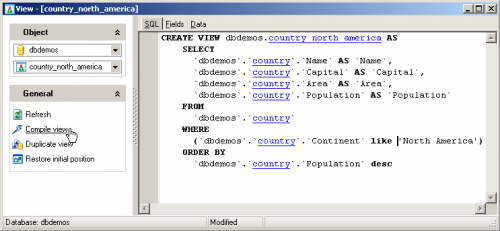
Create new view basing on some tables or another views can be done with MySQL Maestro's Create View Wizard in a very obvious way.
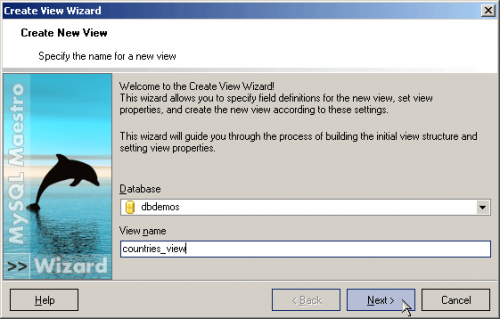
In order to define view, user needs to get permission to invoke the CREATE VIEW command from database owner and have corresponding access to all tables and views that are used in defining that view. Applying MySQL Maestro's Security Manager, DBAs can easily set privileges. Permission management to new MySQL objects is also implemented in MySQL Maestro. That is making MySQL server administration very simple and comfortable.
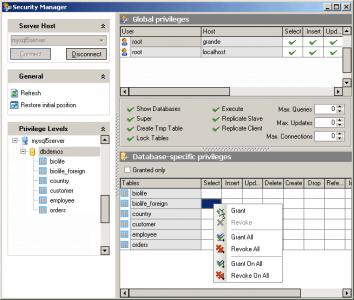
2. Stored procedures and functions
Stored procedures are the set of SQL queries that are kept in the server. Once they are written they cat be implemented repeatedly.
Stored procedures and functions advantages:
-
Performance improvement: stored procedures and functions considerably increase capacity, efficacy and flexibility of SQL. The reason of this is that stored procedures are compiled beforehand. During first procedure execution server's SQL query processor is analyzing procedure and prepare execution plan, which is kept in system table. Later on, procedure is performed according to this plan. Since the main part of query processing has been done then stored procedures are implemented in a moment.
-
Reuse: some algorithm can be realized in stored procedure and then implemented many times. Besides it can be used in common by many clients/applications (even in various languages).
-
Security: stored procedures allow providing more data security degree. Some user can be permitted to invoke procedure. At the same time he/she can't directly modify data that user don't have access through this procedure. For example a seller in bookshop has rights to update information in table BOOK. When a book is bought he brings in changes in table BOOK. At the same time information about author's earnings needs to be changed in table AUTHOR to which seller don't have rights. This can be easily organized using stored procedures.
-
Decrease of network cost: using stored procedures more of the work is done on the server side and less is done on the client/application side. Thus less information needs to be sent between server and client.
If you want easy create your own stored procedures and functions one of the best ways is to use MySQL Maestro's Stored Procedure Editor. This editor allows you to execute the existing stored procedure or edit its definition (procedure name, parameter list, procedure body, etc.). It opens when you create a new procedure or edit the existing one.
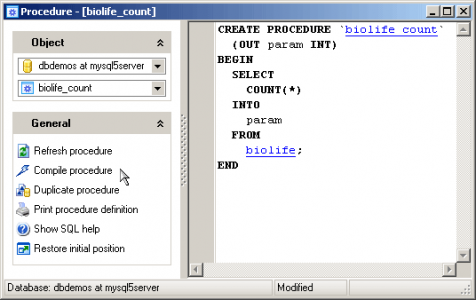
Creating procedures is becoming simple with MySQL Maestro's Create Procedure Wizard that guides you through the process of creating a new stored procedure.
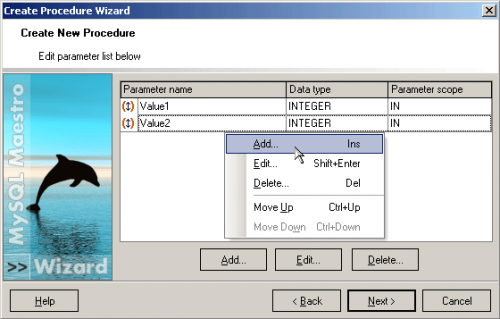
3. Triggers
Stored procedures are very convenient when user needs to develop some complex algorithm and call it in requisite time. But sometimes some acts should be done under certain conditions. In these cases triggers are used. Trigger is a stored procedure that is associated with a table and that activates when a user tries to insert, update or delete data into/from table.
Triggers advantages:
-
Referential integrity provision: user can use triggers for ensuring referential integrity in database. Referential integrity defined in the DELETE FROM statement is rather weak as it can't solve some problems. Cascade data change in interrelated tables is among them. Triggers also allow to support more complicated constrains compared to rules, allow compare modified data and realize some actions as the result of this comparison.
-
Automation: triggers are invoked automatically. They are executed in any case if an event occurs.
-
"If, then"-analysis: triggers can fulfill simple "if, then"- analysis. Trigger can compare table state before and later data modification and act basing this comparison.
Example:
CREATE TRIGGER upd_check BEFORE UPDATE ON book
FOR EACH ROW BEGIN IF NEW.book_price < 0 THEN SET NEW.book_price = 0;
END IF; END; - Business space determination: triggers are very important in automation of business process. Triggers can be used to send manager information about deficient of goods on warehouse and importance of replenishment in case if total amount of goods is less then it is important.
Work with triggers can be simplified with the help of MySQL Maestro's Trigger Editor. This editor allows you to set up trigger properties when you add or edit a trigger. Editing triggers isn't standard for MySQL because there is no ALTER TRIGGER statement, but it is implemented in MySQL Maestro.
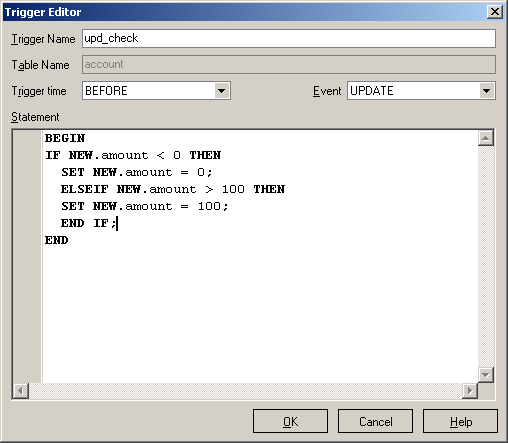
New-appeared MySQL's features (Views, Stored Procedures and Triggers) are making MySQL 5.x rather powerful DB Server that can be used even in large enterprise products. MySQL Maestro has all the tools for developing easy and effective applications starting from small to industrial. Also MySQL Maestro provides DBAs with a lot of tools for DB administration including new objects support.
| Next |








